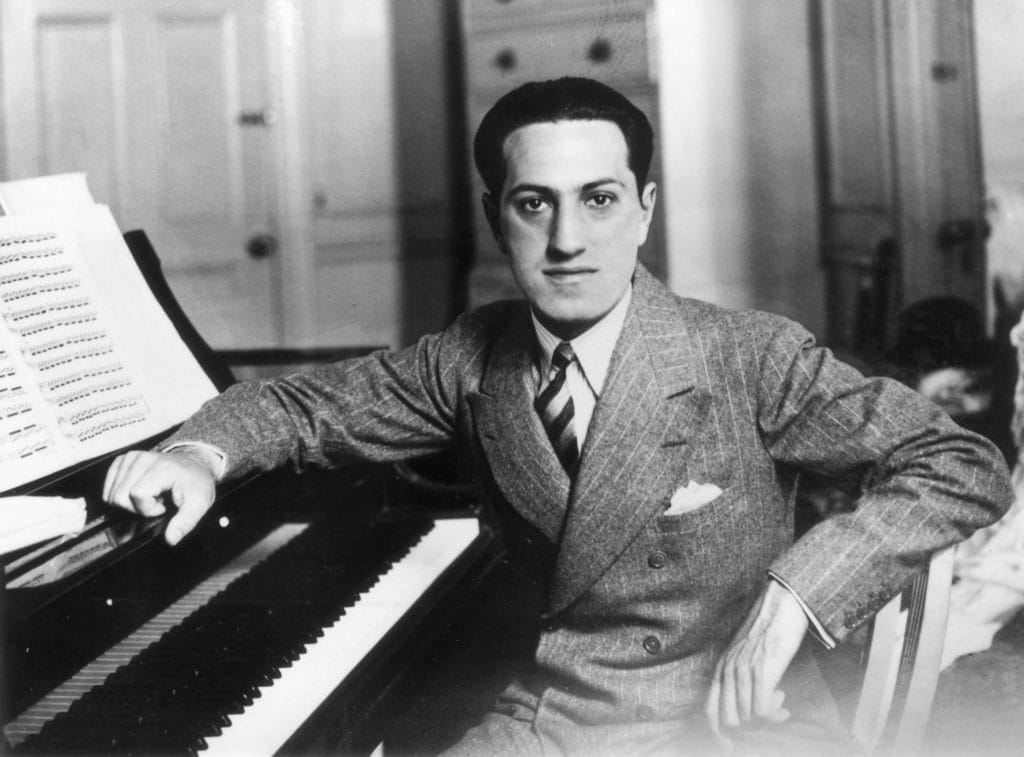Gershwin’s “Rhapsody in Blue” at 100

George Gershwin’s Rhapsody in Blue was premiered one hundred years ago, on the snowy afternoon of February 12, 1924, at Aeolian Hall on Manhattan’s West 43rd Street.
The 25-year-old composer was at the piano, joined by the dance band of Paul Whiteman, the noted bandleader who commissioned the work. It was presented near the end of a marathon concert, organized and promoted by Whiteman, entitled, An Experiment in Modern Music. Purportedly in attendance were such musical luminaries as Sergei Rachmaninov, Fritz Kreisler, Jascha Heifetz, Leopold Stokowski, Ernest Bloch, Igor Stravinsky, Walter Damrosch, Victor Herbert, and John Philip Sousa. Whiteman later recalled that
it was a strange audience out front. Vaudevillians, concert managers came to have a look at the novelty, Tin Pan Alleyites, composers, symphony and opera stars, flappers, cake-eaters, all mixed up higgledy-piggledy.
Weeks before the concert, George Gershwin was playing pool with the lyricist, Buddy DeSylva, at the Ambassador Billiard Parlor at 52nd Street and Broadway, when George’s brother, Ira Gershwin, interrupted the game to read aloud from an unsigned article in the January 4 edition of the New York Tribune. The article, entitled, What Is American Music? promoted Whiteman’s upcoming concert and stated that “George Gershwin is at work on a jazz concerto, Irving Berlin is writing a syncopated tone poem, and Victor Herbert is working on an American suite.”
Gershwin had forgotten, or been unaware of, the commission. At the time, he was busy preparing for the Boston tryout of his newest Broadway show, Sweet Little Devil. Contacting Whiteman by phone the next day, Gershwin agreed to compose a loose rhapsody rather than a full concerto. Additionally, as was customary with Broadway songwriters, he would submit the piece in the form of a two-piano score. The orchestrations would be done by Ferde Grofé, who frequently made arrangements for Whiteman’s ensemble. The score was so hastily assembled that Gershwin had not written out all of the piano solo parts at the time of the premiere, instead playing from memory and improvising. (Beethoven did something similar in initial performances of his piano concertos).
According to Gershwin, it was during the train ride to Boston that Rhapsody in Blue took shape:
It was on the train, with its steely rhythms, its rattle-ty-bang that is so often stimulating to a composer….And there I suddenly heard—and even saw on paper—the complete construction of the rhapsody, from beginning to end. No new themes came to me, but I worked on the thematic material already in my mind, and tried to conceive the composition as a whole. I heard it as a sort of musical kaleidoscope of America—of our vast melting pot, of our unduplicated national pep, of our blues, our metropolitan madness. By the time I reached Boston I had a definite plot of the piece, as distinguished from its actual substance.
In a letter, Gershwin wrote,
Suddenly an idea occurred to me. There had been so much chatter about the limitations of jazz…Jazz, they said, had to be in strict time. It had to cling to dance rhythms. I resolved, if possible, to kill that misconception with one sturdy blow. Inspired by this aim, I set to work composing with unwonted rapidity. No set plan was in my mind—no structure to which my music would conform. The rhapsody, you see, began as a purpose, not a plan.
Although infused with the “blue notes” poetically referenced in its title, Rhapsody in Blue cannot be classified as jazz. Filled with naive optimism and Jazz Age energy, it is a brash fusion of American and European elements. Traditional form is replaced with a parade of bright melodies and an array of instrumental voices which are both comic and soulful. One of the most memorable of these voices remains the long clarinet glissando which opens the piece. In fact, this musical “character” came into focus through an accident of collaboration. Gershwin’s original score contained a scale, and it was Ross Gorman, the clarinetist of the Paul Whiteman Orchestra, who, during a rehearsal invented the glissando, perhaps as a joke.
Rhapsody in Blue remains one of the most iconic pieces of American music. It served as a soaring anthem in advertisements for United Airlines, and as a model for the nostalgic main theme of Ric Burns and James Sanders’ television series, New York: A Documentary Film. It opened the door for Gershwin’s later concert music, and its melodies were fertile ground for genuine jazz musicians such as Glenn Miller, Duke Ellington, Marcus Roberts and Herbie Hancock.
In the years following the premiere, Rhapsody in Blue was most often heard in Ferde Grofé’s 1942 full symphonic scoring. It is this version that we hear in this 1971 recording featuring André Previn leading the London Symphony Orchestra from the piano.





